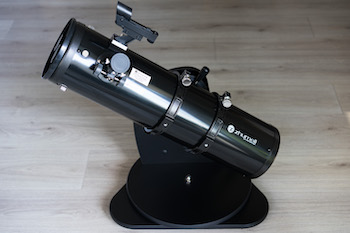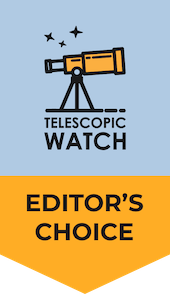Zhumell Z130’s The Optical Tube
The Zhumell Z130 is a 130mm f/5 Newtonian reflector with a focal length of 650mm. This optical configuration is fairly common and available from a broad range of brands on a variety of mountings ranging from tabletop Dobsonians like the Z114, to equatorial mounts, to computerised GoTo rigs.
The Z130, however, is one of the 130mm f/5 variants that for whatever reason has a simpler mirror cell based on old-fashioned Japanese-made reflectors. To collimate the Z130, you have to remove a useless metal back plate with a screwdriver (purely cosmetic, you can throw it away) and then adjust 3 pairs of push-pull screws, also with a screwdriver, which tend to easily strip. The good news about this arrangement is that it holds collimation really well, and you probably won’t have to adjust it very often. The bad news is that it requires tools, stripping the screws in the field may ruin your night if you aren’t near a hardware store that has late hours, and learning how to finely adjust it takes a little more practice.
The Zhumell Z130 has the same 1.25” plastic rack-and-pinion focuser found on many beginner scopes, which may require some shimming and lubricant to work well but is perfectly adequate.
The Z130’s optical tube attaches to its mount with a pair of tube rings and a Vixen-style dovetail – an arguably overkill arrangement that allows you to not only rotate and slide the tube to balance it and position the eyepiece, but also means you can stick it on almost any other telescope mount with no additional tools or hardware. If for some reason you decide you want to use your Z130 on an equatorial or alt-azimuth mount and tripod, this is a huge boon that will save a lot of effort and expense.
Accessories with Z130
Like the other Zhumell tabletops, the Z130 includes two Kellner eyepieces and a red dot finder. In this case, the eyepieces are a 25mm (26x) and a 10mm (65x), and all-metal in construction, albeit lacking rubber eye cups. At f/5, these eyepieces work pretty well and won’t have too many issues towards the edge of the field of view, though they still suffer from the glare problems inherent in the Kellner design and are a bit uncomfortable to use. The included red dot finder is of course adequate for aiming the Z130 thanks to its wide field of view, and is easy to align and understand how to use.
The Z130 also comes with an eyepiece rack with 3 slots that screws to the side of the mount, which some people swear by and others despise. It’s a great way for all of your eyepieces to dew up, but it also makes switching between them a lot more convenient.
There’s no collimation cap included with the Z130, so you’ll have to buy a cap, Cheshire tool, or laser, or you can always make your own collimation cap out of a film canister or cardboard in a few minutes. Check out our collimation guide to learn more about this process and how you can collimate your Z130.
Z130’s Tabletop Dobsonian Mount

The Z130 attaches to its tabletop Dobsonian mount with its Vixen-style dovetail and rings. Like most tabletop scope mounts, the Z130’s mount is technically a single-armed fork and not a “Dobsonian”, but there’s no need to debate the nomenclature too much. You can adjust the balance of the tube by either sliding it in its rings or sliding the whole dovetail plate in the saddle. For adjusting the friction on the mount, you tighten and loosen the large knob for altitude, while adjusting the friction in azimuth requires two wrenches or pairs of pliers to move the lock nut.
In addition to sporting the eyepiece rack we’ve already mentioned, the Z130’s mount has some cutouts for handles, which helps with carrying the somewhat-heavy scope in one piece.
The Z130 is advertised as a tabletop scope, but tables capable of holding it in a stable fashion, let alone when using the telescope at high magnifications and tracking targets by hand, are few and far between. The Z130 is also actually somewhat tall to be used on a table, especially while seated. It also wouldn’t be a good idea to put it on a bar stool or the hood of your car. As such, we’d recommend putting it on a milk crate or building a homemade wooden stand.
Alternative Recommendations
- The Sky-Watcher Heritage 130P is essentially a boneless Z130, with a collapsible strut tube instead of a solid metal one. This means it’ll fit in a smaller space and weighs less, but needs a shroud and will lose collimation more frequently (though collimating it doesn’t require tools). The focuser is also slightly inferior.
- The Sky-Watcher Heritage 150P offers a little more aperture than the Z130 and 130P, albeit at a higher price and with the same compromises as the 130P.
- The various 6” f/8 Dobsonians sold by Orion, Sky-Watcher, and Apertura offer more aperture than the Z130 and don’t require a table, but do have a significantly higher price tag.
Aftermarket Accessory Recommendations
The Zhumell Z130 comes with a decent enough pair of 1.25” Kellner eyepieces, but we recommend augmenting them with at least a couple more eyepieces for a wider range of magnifications to get the most out of this telescope. We also highly recommend using a Cheshire collimation tool to ensure accurate collimation of the Z130’s optics for the sharpest possible views, since nothing is provided to collimate the Z130 and it’s difficult to make on-the-fly adjustments with the Z130’s mirror cell design, since you’ll need to use a screwdriver.
For medium-power observation with the Z130, we suggest choosing between a 17mm Plossl (44x magnification) or a 15mm “redline”/”goldline” eyepiece (50x magnification). Although the redline/goldline’s optical design loses sharpness towards the edges of the field of view with a fairly fast scope like the Z130, it provides a wider and more immersive view than a 17mm Plossl or Kellner with slightly better contrast too.
While not necessarily required, we also recommend a 9mm redline/goldline eyepiece (72x magnification) to replace the Z130’s provided 10mm Kellner eyepiece. The redline/goldline eyepiece design boasts a considerably wider apparent field of view, around 70 degrees compared to the Kellners’ 50-degree apparent field. It also offers greater eye relief than the 10mm Kellner, providing more comfortable viewing and improved sharpness towards the edges of the field of view, along with a slight increase in magnification.
For even higher magnification, consider a 6mm goldline/redline (108x magnification) and/or a 2x Barlow lens (achieving 130x magnification with the provided 10mm Kellner, and 144x/217x magnification when used with the 9mm and 6mm redline/goldline eyepieces respectively). Due to the turbulence in our planet’s atmosphere, which often blurs the view, you may not frequently use magnifications over 200x with this telescope. However, the Z130’s optics can handle up to 250x magnification, at least in theory.
Finally, a narrowband Ultra High Contrast (UHC)/OIII nebula filter can significantly enhance your observation of nebulae, such as the Orion Nebula, when employed with the Zhumell Z130 or almost any other telescope with sufficient aperture. This specialised filter also facilitates the location of planetary nebulae by reducing the brightness of surrounding stars and darkening the background sky, allowing these elusive celestial objects, often referred to as “faint fuzzies,” to be more easily discernible at lower magnifications. Furthermore, this filter provides sufficient contrast improvement to enable the observation of previously invisible targets, such as the Veil Nebula supernova remnant, which becomes visible when using this telescope equipped with a filter under dark skies.
Should I buy a Used Zhumell Z130?
The Z130 is a great scope, and being a relatively new product not many of them have been able to waste away in neglect, so you’re unlikely to find a used one in poor condition. A missing base is not a problem in the slightest, as the Z130 can fit on other mounts with its dovetail plate. Damaged mirror coatings are unfortunately not worth repairing, however, as recoating the optics costs almost as much as the Z130 itself. Dents to the tube that don’t affect the installation of any hardware can be safely ignored. Missing eyepieces can also be replaced, though this can get expensive fast.
What can you see with Zhumell Z130?
The Zhumell Z130 is just at the threshold of being able to give you seriously interesting views of the Moon, planets, and deep-sky objects without being merely a sampler you get tired of.
With the Z130, you’ll actually be able to resolve globular clusters like M13 and M22, albeit barely, and under dark skies the Z130 can show you the spiral arms and dust lanes in bright galaxies like M51, M106, and M33 – though keep in mind that without truly dark skies where the Milky Way is obvious overhead, these galaxies are reduced to small fuzzy patches or become completely invisible altogether. Planetary nebulae also transform from boring patches of light to at least semi-colorful targets with details and personalities of their own, the exception being the comparatively gigantic Ring, Helix, and Dumbbell, which make up for their lack of colour or fine detail with their huge angular sizes. And of course, there’s always the various emission nebulae like Orion and dozens if not hundreds of sparkling open clusters, as well as thousands upon thousands of interesting and colourful double and variable stars.
Within the Solar System, the Z130 easily shows the phases of Venus and Mercury, and details just a few miles/kilometres across on the Moon – you could spend a lifetime looking at just the Moon and never get tired of it, especially if you wake yourself up early or stay up late enough to view the less-frequently-enjoyed details when it is waning past full.
Further out, there’s Mars and its ice caps, with any dust storms easily visible as they not only obscure all other detail but transform the planet into a more beige-orange colour. Around opposition, a few dark markings on Mars such as Syrtis Major can be spotted with ease, and skilled observers can spot its outer moon Deimos with lucky timing and by putting Mars and its glare outside the field of view.
Jupiter’s cloud bands look magnificent, with various swirls, festoons, and of course the Great Red Spot able to be seen on a steady and clear night. The moons of Jupiter are no longer mere pinpoints but worlds in their own right – albeit tiny disks, and only clearly distinguishable as such when they transit the planet and cast shadows in their wake.
Saturn’s rings are easy to see with the Z130, as is the gap in the rings known as the Cassini Division. You can also see quite a few moons, and some cloud bands on Saturn itself. Uranus is easy to distinguish from a star at high magnification but its moons are too dim to see, while Neptune is a bit more difficult and its moon Triton is right on the threshold of being visible with the Z130 – give it a shot, but it’s not guaranteed.



I just purchased one and I think collimation is the trouble. I have an Orion 90mm and I compared the view and my Orion is much clearer. Im relatively new to stargazing and I bought a collimation tool to see if that is the trouble with it being less detailed than my Orion. Im not disappointed with it but my hopes were kind of dashed Thanks for your review!